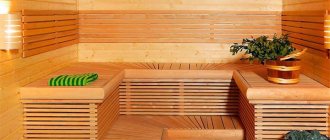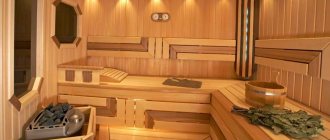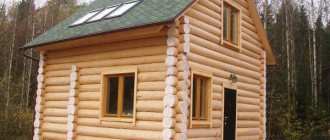Larch bathhouse
When choosing a material for a bathhouse, you need to take into account not only the heat capacity of wood, but also other characteristics. Unlike a residential building, the wood here is exposed to intense exposure to steam, water and temperature fluctuations, because the building is heated only during bathing. Not every material can withstand such a load.
An excellent option for a bathhouse is larch. The tree is a coniferous tree, meaning it contains a fairly large amount of resin. High resin content ensures amazing resistance of larch to rot, fungi, and water.
If the products are made of pine, it is necessary to varnish and protect them from moisture. Larch does not need this. On the contrary, over time it only becomes stronger than oak.
The advantages of wood are not limited to unique resistance to decay. Accordingly, a larch bathhouse will have the following features:
- strength - the density of larch is only slightly less than that of oak, a structure made from this tree will last a long time, as it is not subject to mechanical damage;
- resistance to rain, snow and heat ensures the longevity of the bath;
- larch lining includes a small number of knots, and this means not only aesthetics, but also greater strength of the boards and logs themselves;
- the wood has a beautiful texture and is very attractive;
- a log bathhouse made of larch does not require any protective measures; there is no need for periodic treatment with antiseptics, insect repellents, or stains;
- lining made from this material has the same advantages as logs.
There are also disadvantages to a bathhouse made of larch:
- it is at least 2 times more expensive than pine;
- wood is processed with some difficulty, so the bathhouse itself will also cost more.
Comment! Larch floors are still used in European castles. Its age reaches 300–400 years.
Aspen bathhouse: pros and cons
If larch is used both as the main material and as a finishing material for the steam room, then with aspen the situation is different. This tree is very specific and not cheap. Moreover, the cost is determined not by high qualities, but by the features of the workpiece.
Aspen grows in wetlands, which causes the inside of the trunk to rot. You can only harvest aspen tops up to 4–5 m in length. The rest of the tree is unusable and is simply thrown away. In addition, aspen harvesting is only possible from March to May, while aspen is relatively easy to process. This “seasonality” makes the collection and supply of material a very expensive endeavor.
And yet, this is the material that people often prefer to linden and alder. In fact, the disadvantages of aspen turn into advantages when it comes to the steam room:
- aspen - hardwood, boards or lining from it do not emit resin, which is a valuable quality for a sauna;
- wood does not heat up as much as many other species, this eliminates the possibility of burns;
- out of 3 trunks, only one turns out to be suitable for construction, but it is extremely resistant to moisture and does not rot;
- wet aspen is easy to process; when dried, it shrinks greatly, but at the same time the tree acquires exceptional strength.
An aspen bathhouse lasts for decades, and over time it only becomes stronger.
Important! Aspen wood is very wet and shrinks greatly when dried. However, once it dries, it becomes rock hard.
Linden or aspen for a bath: which is better?
It's really difficult to choose between these two materials. Linden is traditionally considered the best tree for a bathhouse and deservedly so. However, aspen, despite its external ugliness, poses serious competition to it.
Linden wood is soft, it is easy to process, and accordingly, the construction of a bathhouse requires less cost. If dried logs were used, the building does not shrink and can be used immediately after completion of construction.
Aspen, on the contrary, is processed with great difficulty. Since a bathhouse requires well-dried material, this makes construction an expensive and time-consuming task.
The softness of linden is also its disadvantage - the tree is short-lived, but dry aspen acquires the hardness of stone and lasts an exceptionally long time. Linden does not need to be processed for aesthetic purposes; even an unsanded log looks great, not like lining. To give aspen an aesthetic appearance, you should trim the bark from the log, sand it and plan it. In addition, repeated grinding will be required - the latter is performed 3 years from the date of laying. Otherwise, instead of a silver-white bath, you get a gray, unsightly one with dark spots.
Linden is not resistant to rotting and fungal attack. The bathhouse requires periodic treatment with special preparations. Aspen is not susceptible to rot or fungi. The only treatment that may be needed is for wasps. For some reason, the latter really love this tree.
The cost of linden is higher than that of aspen, so it is really difficult to choose.
Important! A log house for a bathhouse made of aspen and linden, as confirmed by reviews from builders, does not require additional finishing of the steam room. Both breeds are certainly suitable for sauna lining.
How to distinguish linden from aspen
Lining made from linden and aspen is very easy to confuse. It is not so easy to distinguish wood.
First of all, pay attention to the color. The wood of linden lining is very light, but still has a coffee tint. Against its background, the aspen is almost snowy white.
Linden boards have a characteristic sweet aroma. The smell of aspen is bitter, more reminiscent of birch sap. Aspen lining is rarely truly smooth, since this wood is difficult to process, but linden is smooth and silky;
Knots in aspen lining are more common. They are darker and clearly visible. In category B, even falling knots are possible here.
To distinguish linden boards from aspen boards, you need to not only inspect them, but also try them by touch.
What is better in a steam room: aspen or linden
The choice between linden and aspen lining is even more difficult. The materials have a number of common properties that are very useful for saunas and steam rooms:
- both linden and aspen do not heat up as much as other types of wood;
- shelves and walls finished with clapboard remain pleasant to the touch and do not burn;
- the wood of both species releases aromatic oils that are beneficial to health;
- the lining looks equally aesthetically pleasing;
- Both linden and aspen tolerate steam well.
There are also differences between linden and aspen:
- the smell of linden wood is deservedly considered the most pleasant, while that of aspen is bitter and not everyone likes it;
- linden darkens over time, aspen practically does not change color;
- linden lining is susceptible to fungus, the finishing must be treated, but aspen does not have this drawback;
- linden costs almost 2 times more than aspen lining, but linden wood contains far fewer knots and stains and looks more beautiful.
For a steam room, linden or aspen linings are equally good. The choice determines the taste of the owner.
FAQ
I want to cover a timber wall with foil and clapboard on it. Is this finishing option possible?
The advantage of a wooden bath is the ability of the material to independently regulate temperature and humidity. Enter the brick bathhouse, lined with clapboard and wooden. In the latter, the steam is softer and more pleasant. Foil neutralizes these advantages and you end up with something in the form of a thermos.
The larch in the steam room began to spew resin. Can it be removed or does the casing need to be replaced?
No need to change the casing. The resin can be drawn out of the wood and removed. Preheat the bath to maximum temperature. As soon as the room has cooled down, scrape off the released resin with a spatula, then wash the wood with a solution of 25 g of liquid soap and 50 ml of ammonia per 1 liter of water. Repeat the procedure until the discharge stops.
The paneling in the steam room has darkened and the view is somehow not pleasing. Is it possible to return the previous light color?
Treat the walls with chlorine-based bleach, special (Neomid, Sagus) or household. Then run the sauna dry to remove chemicals.
Which tree to choose if you are sensitive to odors?
Poplar. It produces practically no odor when heated, since it does not contain phenols, and is widely used even in baths and saunas for medical purposes.
The choice of wood for the interior decoration of a bathhouse should be deliberate. It is worth considering not only the external, but also the technical characteristics of the material, as well as the microclimate features of a particular room.
Cedar for a bath
Noble cedar wood belongs to the elite category. The material has exceptional qualities, not only functional, but also medicinal.
Cedar wood is impregnated with unusual resinous substances. They call it gum, emphasizing its special qualities. It has an antibacterial effect not only on the wood itself, but also on the environment. When heated, the substances begin to evaporate, disinfecting the room and relieving a person of a wide variety of diseases, so cedar is ideal for a steam room.
Important! In Siberia, a bathhouse decorated with cedar clapboard is recommended for those suffering from diseases of the respiratory system. The tree can even cure bronchial asthma.
Log bathhouse made of cedar
Cedar is the best option for a bath. The qualities of wood provide the log house with durability, beauty, and convenience:
- cedar has the lowest thermal conductivity compared to other conifers; a cedar bathhouse is warm even in the bitterest frosts;
- the wood is resinous, provides excellent antiseptic properties, therefore, it does not rot, is not susceptible to fungus, and even insects are not able to damage it;
- cedar resins are healing, cedar finishing provides an excellent antibacterial effect and natural air ionization;
- cedar is resistant to moisture and temperature changes. A cedar bathhouse is very durable and will last at least half a century;
- both the logs and the lining are very beautiful and do not need any processing: the natural color and texture are beyond praise.
There is only one drawback to cedar wood or lining - high cost.
Cedar lining for a bathhouse
Cedar lining for a bathhouse has all the advantages of a log. This material is ideal for a steam room, although it is not as effective as aspen:
- gum resin evaporates, but does not release when heated, so cedar lining does not burn and does not leave resinous stains;
- cedar lining guarantees an excellent healing effect;
- the specific fibrous structure of the wood ensures the absence of cracks and chips even at the ends;
- the lining is very beautiful: the colors are even, muted, the knots are small, the panels are smooth and delicate to the touch;
- the material is not afraid of moisture, steam, mold, or rotting, so it does not need any processing.
Important! Over time, cedar lining darkens, or rather, acquires a brownish tint.
Cedar bath: photo
Cedar is an excellent building material and allows you to implement any project - from a traditional Russian bathhouse to a complex hotel complex.
Finishing with paired cedar lining is no less impressive and beautiful and is suitable for any style.
Requirements for lining for the steam room and living room
Of course, since the living room in the bathhouse, steam room and washing room are characterized by different temperature and humidity conditions, the requirements for the cladding material are somewhat different. If a steam room requires lining with low thermal conductivity and resistance to high humidity and temperature, then for lining a living room, aesthetic qualities, cost and service life come first.
So, the most important requirements for the material for covering a steam room:
- Environmental friendliness. At high temperatures, all substances contained in the material are released into the steam room air. Therefore, plastic panels in the steam room are unacceptable, therefore antiseptics are not used in the steam room.
- Low thermal conductivity. The lower it is, the lower the risk of getting burned by leaning against the wall, and the lower the heat loss in the bathhouse.
- High resistance to water.
- Beauty.
- Reasonable cost
Alder for a bath
Another traditional material is gray and black alder for the bathhouse. The wood of these species has a very unusual porous structure. This feature makes alder lining a suitable option for a bathhouse:
- gray and black alder practically does not shrink. Due to its high porosity, moisture evaporates very quickly, this quality makes the lining an extremely suitable solution for a steam room;
- the wood is soft, easy to process at any stage, so the construction of an alder bathhouse will not require large expenses;
- sauna lining made of alder does not warp or deform even after several decades;
- wonderfully beautiful shades - from fiery to brick, give the building real beauty;
- In the dressing room, it is recommended to open the lining with wax to emphasize the color and texture.
However, judging by the reviews, alder for baths also has serious disadvantages.
- Wood is not very resistant to water. On the one hand, in the steam room moisture evaporates from the pores, and this is a plus. However, at low temperatures it stagnates in the pores and causes rotting. The external side of the log house requires periodic processing.
- Over time, the alder darkens almost to black.
- The cost of the lining is quite significant. The fact is that alder wood includes many knots. To get rid of them, a very thick layer of wood is cut from the trunk. In this case, the whips are short, and the material is expensive.
- The alder bathhouse needs insulation: there are too many joints.
Alder baths are built in mid-latitudes, where there is no need to insulate it.
Conclusion
Whatever choice you make, remember that the decoration of the bath should be both beautiful and useful. Therefore, you should choose only high-quality wood with beneficial properties. In addition, durability is also of great importance, because making repairs every few years is very costly and expensive.
It will become even easier for you to make your choice if you watch the video in this article.
The traditional material for building a bathhouse or sauna is wood. And it’s hard to imagine the interior decoration of the steam room without natural wooden lining. It creates a special microclimate, retains heat, and has an attractive appearance. The main advantages of lining made from natural wood are durability and environmental friendliness. The question remains: which wood is more suitable for a steam room.
The wooden lining in the steam room looks beautiful and has excellent performance characteristics
Reviews
Boris Nevelov, 42 years old, Novosibirsk
I hesitated for a long time between linden and aspen, but in the end I made the traditional choice: linden. It costs more, but for a steam room, I think, you won’t find a better one. The wood is warm, silky, and does not heat up. And the smell in the steam room will make you pumped.
Nikolay Morozov, 35 years old, Omsk
There used to be a bathhouse on the site - made of pine. The inside of the steam room was lined with linden. But something went wrong: it began to rot. And in the bathhouse there was always mold or something else. They dismantled and built a new one - from aspen. It has been standing for more than 6 years, nothing rots, there is no trace of fungus. But, of course, it took me a long time to choose a tree. I went to the base three times to take away the barrels.
Alexander Fedorov, 52 years old, Ufa
A bathhouse was started on the site as soon as the house began to be built. I chose aspen: the price is lower than cedar, and it is not afraid of water, if it is good. Banya is already 15 years old. The color, of course, is not the same, it has become gray, but the tree is like stone. During all this time there was never mold in either the steam room or the dressing room.
Recommended Posts
Bathhouse made from a sea container
Bathhouse made from sleepers
Sauna tent
Do-it-yourself bathhouse repair
Russian wood-fired sauna
Why is there no draft in the sauna stove?











